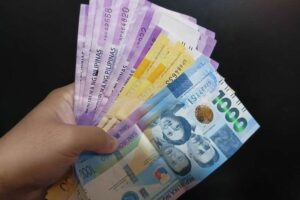Peso sinks to seven-week low on Fed rate bets
THE PESO sank to a near two-month low against the dollar on Monday due to dimming expectations of another large rate cut by the US Federal Reserve after strong jobs data released last week and the escalating conflict in the Middle East. The local unit closed at P56.825 per dollar on Monday, dropping by 53 […]

THE PESO sank to a near two-month low against the dollar on Monday due to dimming expectations of another large rate cut by the US Federal Reserve after strong jobs data released last week and the escalating conflict in the Middle East.
The local unit closed at P56.825 per dollar on Monday, dropping by 53 centavos from its P56.295 finish on Friday, Bankers Association of the Philippines data showed.
This was the peso’s worst close in more than seven weeks or since it finished at P57.245 per dollar on Aug. 16.
The peso opened Monday’s session sharply weaker at P56.64 against the dollar. It traded lower than Friday’s close the entire session as its intraday best was at just P56.58, while its worst showing was at P56.84 versus the greenback.
Dollars exchanged went down to $1.295 billion on Monday from $1.51 billion on Friday.
“The dollar strengthened due to escalating geopolitical tensions in the Middle East and after the higher US nonfarm payroll report last Friday, easing bets of a 50-basis-point (bp) rate cut by the Fed,” a trader said by phone.
Higher global crude prices due to conflict in the Middle East dragged the peso down, Rizal Commercial Banking Corp. Chief Economist Michael L. Ricafort added in a Viber message.
For Tuesday, the trader sees the peso moving between P56.50 and P57 per dollar, while Mr. Ricafort expects it to range from P56.70 to P56.90
The US dollar edged down on Monday after a rally sparked by Friday’s strong US jobs data and an escalation in the Middle East conflict, Reuters reported.
The dollar’s gains followed a US jobs report that showed the biggest jump in six months in September, a drop in the unemployment rate and solid wage rises, all pointing to a resilient economy and forcing markets to reduce pricing for Federal Reserve rate cuts.
Many of the factors that weighed on the greenback through the summer had reversed, analysts said, mentioning fading recession concerns and a price action suggesting the limits of pricing a dovish reaction function have been reached with this dataset.
The dollar index measure against major peers was down 0.05% at 102.48. It rose 0.5% on Friday to a seven-week high, logging more than 2% gains for the week, its biggest in two years. It was slightly above 100 early last week.
Markets expect the Federal Reserve to cut rates by just 25 bps in November, rather than 50 bps, following the jobs data. They now price in a 95% chance of a quarter point cut, up from 47% a week ago, and a 5% chance of no cut at all, according to CME’s FedWatch tool
In the Middle East, Israel bombed Hezbollah targets in Lebanon and the Gaza Strip on Sunday ahead of the one-year anniversary of the Oct. 7 attacks that sparked its war. Israel’s defense minister also declared all options were open for retaliation against arch-enemy Iran. — A.M.C. Sy with Reuters























